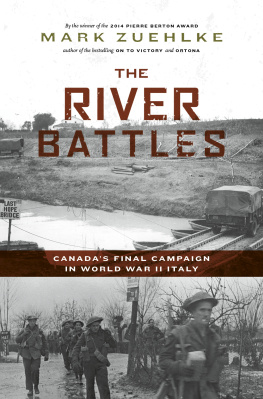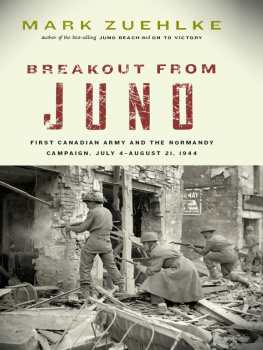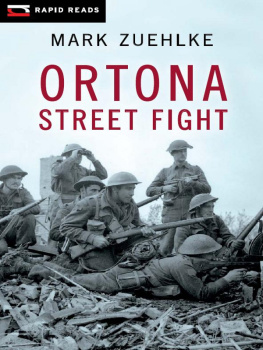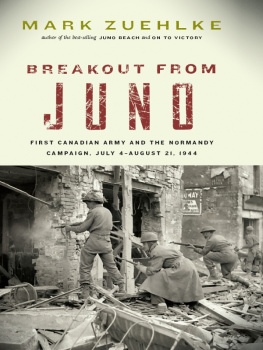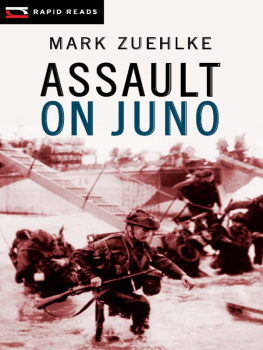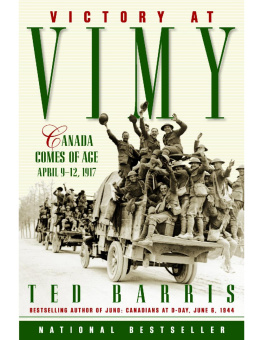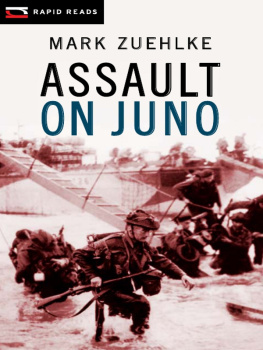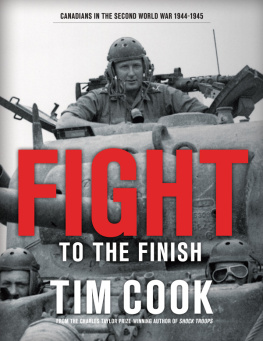Holding Juno
HOLDING JUNO
CANADAS HEROIC DEFENCE OF THE D-DAY BEACHES: JUNE 712, 1944
MARK ZUEHLKE

Copyright 2005 by Mark Zuehlke
05 06 07 08 09 5 4 3 2 1
All rights reserved. No part of this book may be reproduced,
stored in a retrieval system or transmitted, in any
form or by any means, without the prior written consent of the publisher or
a licence from The Canadian Copyright Licensing Agency (Access
Copyright). For a copyright licence, visit www.accesscopyright.ca
or call toll free to 1-800-893-5777.
Douglas & McIntyre
2323 Quebec Street, Suite 201
Vancouver, British Columbia
Canada V5T 4S7
www.douglas-mcintyre.com
National Library of Canada Cataloguing in Publication Data
Zuehlke, Mark
Holding Juno : Canadas heroic defence of the D-Day beaches,
June 712, 1944 / Mark Zuehlke.
Includes bibliographical references and index.
ISBN13: 978-1-55365-102-4
ISBN10: 1-55365-102-2
1. World War, 19391945CampaignsFranceNormandy.
2. Canada. Canadian ArmyHistoryWorld War, 19391945. I. Title.
D756.5.N6Z825 2005 940.5421422 C2005-901195-5
Library of Congress information is available upon request
Editing by Elizabeth McLean
Jacket and text design by Peter Cocking
Jacket photograph Private Hole, LAC PA-177100
Typesetting by Rhonda Ganz
Printed and bound in Canada by Friesens
Printed on acid-free paper
Distributed in the U.S. by Publishers Group West
We gratefully acknowledge the financial support of the
Canada Council for the Arts, the British Columbia Arts Council,
and the Government of Canada through the Book Publishing Industry
Development Program (BPIDP) for our publishing activities.
OTHER MILITARY HISTORY BY MARK ZUEHLKE
Juno Beach: Canadas D-Day Victory: June 6, 1944 *
The Gothic Line: Canadas Month of Hell in World War II Italy *
The Liri Valley: Canadas World War II Breakthrough to Rome *
Ortona: Canadas Epic World War II Battle *
The Canadian Military Atlas: The Nations Battlefields from the
French and Indian Wars to Kosovo (with C. Stuart Daniel)
The Gallant Cause: Canadians in the Spanish Civil War, 19361939
* Available from Douglas & McIntyre
When will the earth grow weary of the shock
Of this chaos? When, with impatient hands,
Will it obliterate the shame and mock
Of desolation glutton war demands?
BOMBARDIER W.S. BEIRNES,
3RD CANADIAN INFANTRY DIVISION
Valour is of no service, chance rules all,
And the bravest often fall by the hands of cowards.
TACITUS, THE HISTORIES
If I get out of this, Im not going to take shit from anyone.
LIEUTENANT BILL MCCORMICK,
1ST HUSSARS
[ CONTENTS ]
PREFACE
IN THE SPRING OF 2004, on the sixtieth anniversary of the Allied invasion of Normandy, my book Juno Beach: Canadas D-Day Victory: June 6, 1944 was released. Detailing the Canadian experience in that momentous event, it spanned a single day. My original plan had been to carry the story beyond June 6 and include the bitter fighting that raged between June 7 and June 12 as the Germans attempted to cast the invasion forces back into the icy English Channel. But it had been with good reason that Cornelius Ryan entitled his book on the invasion The Longest Day. So much transpired to so many Canadians during the landings, their fierce battle to win the sand, and then the deadly advance inland towards final objectives that the book threatened to grow to Tolstoy-like thickness. Phone calls were made, e-mails exchanged, and on a chilly December day my publisher Scott McIntyre and I agreed to divide the story. We opted to focus the spotlight of the second book on a period of history normally compressed, as I had originally planned, onto the back end of books about D-Day, or barely mentioned in broader works that cover the Normandy campaign or the entire war. Holding Juno is the resultthe second in a planned series of works covering the Normandy campaign.
To my knowledge, this is the first book purely dedicated to Canadas role in the six days dubbed the bridgehead battle by Colonel C.P. Stacey, the Department of National Defence official historian of the World War II Northwest Europe campaign. I embarked on this idea with some trepidation. Did enough happen to the Canadians during those days to warrant lengthy treatment? Would there be enough historical documentation to unravel the ebb and flow of battle? Were these days a period that war veterans remembered with any clarity?
I soon determined the answer to all these questions was an unqualified yes. Many veterans described this fight as the toughest they ever lived through, worse than D-Day itself. Delving into the unit war diaries, after-action reports, and regimental histories unearthed a vast amount of material. As had been the case with my other books on Canadas experiences in World War II, the problem was not finding too little compelling material but rather discerning what must be set aside. It is especially difficult to decide that various accounts by veterans have to be excluded for simple want of space.
As in earlier books, I have sifted veteran accounts here through the filter of official records generated by the military at the time, in order to create a narrative that honours their remembrance while remaining historically accurate. This is not a purely oral history where the story is confined to the memory of participants without interpretation or expansion. Such works have their place and merit, but often lack context that would enable readers unfamiliar with the period to align the experiences into an understandable whole. As is often the case, particularly as veteran memory fades with the passage of years, few can recall in full detail what they and comrades endured. Like creating a patchwork quilt, it is necessary to stitch one recollected detail in front of, alongside, or behind incidents provided by other veterans, anchored together by historical record to create a fully realized account.
I leave it to the men who lived through those days when none knew if they would be able to hold Juno Beach and ensure the invasions success to decide whether I came close to getting it right. They buried friends and brothers in the Norman soil and carried home with them countless images and emotions experienced during those terrible days of battle.
ACKNOWLEDGEMENTS
WITHOUT THE WILLINGNESS of veterans to delve into the past and relate often painful, long-buried memories, a book such as this would not be possible. My thanks to all who did, and they are listed in the bibliography. Once again, I am greatly indebted to John Gregory Thompson of Ingersoll, Ontario for his interviews of veterans scattered throughout the southern part of that province. Ken MacLeod of Langley, B.C. shared his large collection of video and audio interviews conducted over many years. John Bardsley of Victoria took on the task of interviewing other veterans. At Royal Military College, Major Michael Boire provided interviews with lieutenant colonels Don Mingay and Ernest Ctkey officers in 3rd Canadian Infantry Division. Michael also dug into the RMC records on my behalf and unearthed much material on the divisions three infantry brigadiers.
David OKeefe at the Black Watch Regimental Museum in Montreal provided essential information on Brigadier Ken Blackader that I would not otherwise have found. Staff and volunteers at other regimental museums and archives also generously assisted where they could. The Royal Canadian Military Institute in Toronto kindly opened their excellent library to my study. In Ottawa, staff at the Department of National Defences Directorate of Heritage and History, the Canadian War Museum library and archives, and Library and Archives Canada were as essential in helping me track down key documents. Carol Reid at the war museums archives deserves special mention. As does Roger Sarty, for helping me lay hands on vital documents covering the Royal Canadian Navys role in the bridgehead battles. In Victoria, staff of the University of Victorias Special Collections were once again a pleasure to work with and Doctor Reginald Roys collection is a treasure. A World War II veteran, the former Military History Chair at UVic used this position wisely, creating a notable library collection and vast oral and documentary archive.
Next page

